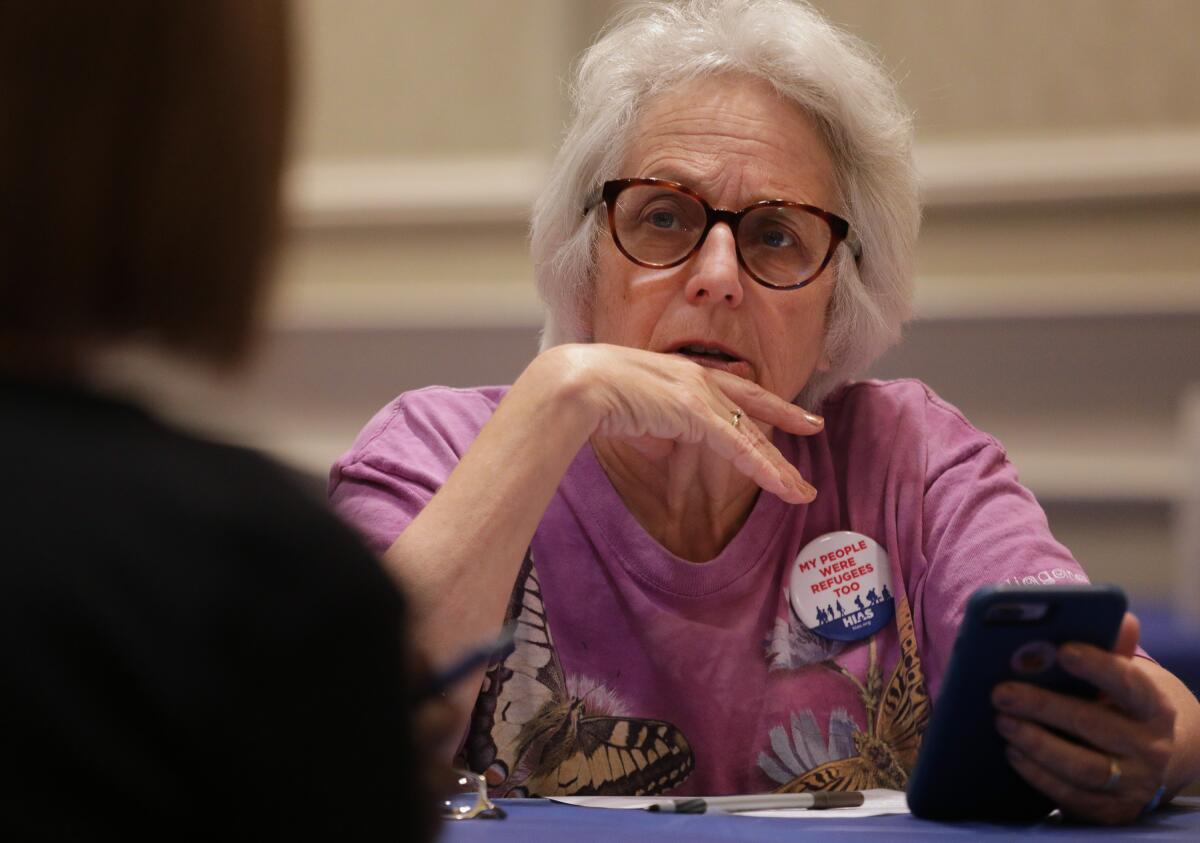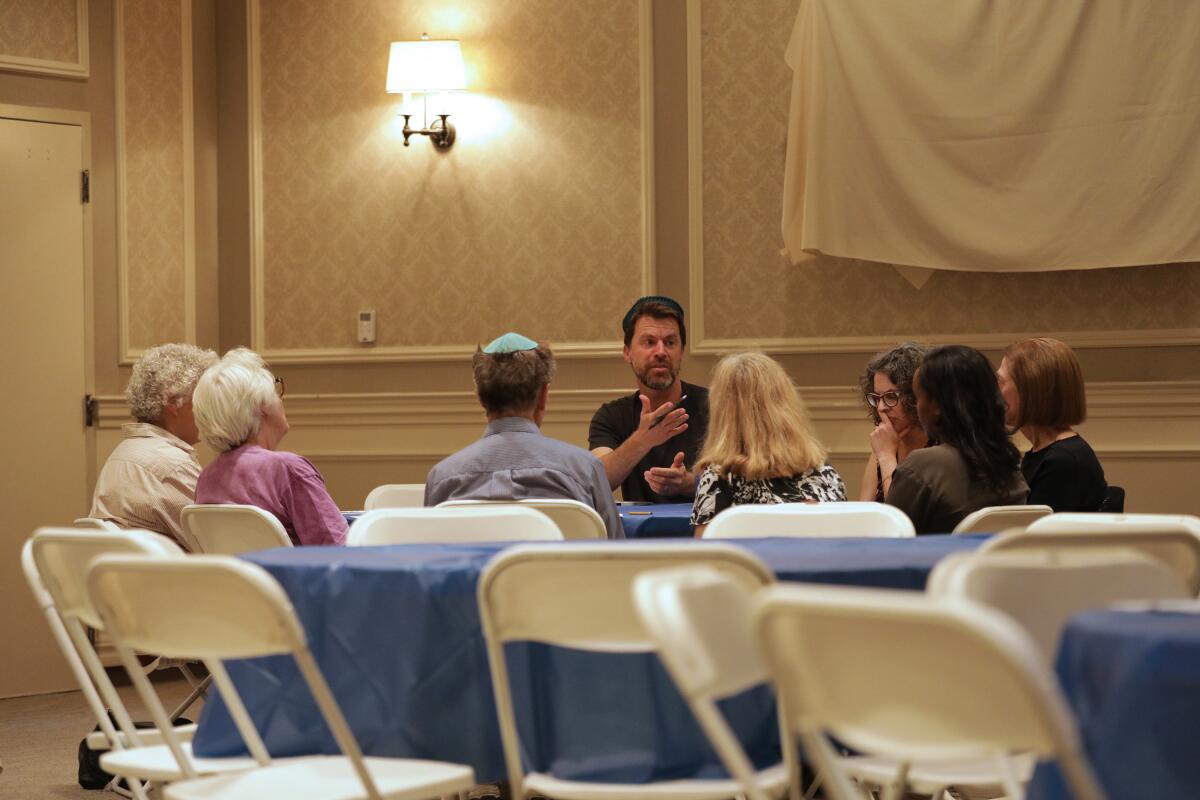Family separation and refugee cap reinvigorate Jews’ activist roots: ‘We’ve always been immigrants’

- Share via
His voice booming through a loudspeaker, Rabbi Aryeh Cohen stood near an immigrant detention center in downtown Los Angeles and urged an end to the Trump administration’s family separation policy. Surrounded by more than 200 members of the Jewish community on their annual day of mourning, Tisha B’av, Cohen stressed the importance of moving the traditional fast from the synagogue to the streets.
The rabbi’s passionate message wasn’t directed at only followers of his faith. It was squarely aimed at Mexicans, Central Americans and other immigrants struggling to gain asylum in the United States — modern refugees, not unlike many Jews in generations past.
“The Jewish community with one loud voice is saying, ‘Close the camps,’” Cohen told the protesters gathered at the Metropolitan Detention Center, a prison facility used to temporarily house immigration detainees. Some nodded, holding signs above their heads that read, “This is what ‘Never Again’ looks like,” and “All immigrants are welcome here.” Together, they recited the mourner’s Kaddish, the prayer for the dead.
“Treat migrants, treat those seeking asylum like human beings,” the rabbi thundered. “Don’t cage them. Don’t separate families.”
The demonstrators at the Aug. 11 rally, joined by thousands of other Jews — Reform, Conservative and Orthodox — at similar rallies across the country, broadcast the growing activism of Jews opposed to the government’s crackdown on immigration. Just days before, a group of young Jewish activists with the recently formed group Never Again Action, had descended on the Los Angeles offices of GEO Group Inc., a private prison company that runs the immigrant detention facility in Adelanto, and demanded that the company end its contract with the government.
Jewish Americans’ support for immigrant rights stems from their own experiences in the late 1800s, when European Jews began migrating en masse to the United States, fleeing the Russian czars’ pogroms and other anti-Semitic persecution in their home countries. Their increasingly vocal stance in the Trump era flows from that long tradition, said Jonathan Sarna, a professor of American Jewish history at Brandeis University.
“They are in fact continuing perhaps the oldest social cause that Jews took up and one that almost all supported,” he said.
Jews played a leading role in the battle to keep America’s gates open during the time of the Chinese Exclusion Act in 1882; in the mid-1920s, when the U.S. imposed strict immigration quotas; and again in the aftermath of World War II, when Jewish activists were vocal supporters of the civil rights movement, Sarna said.
Now, amid continuing uproar over policies such as family separation, reduced refugee admissions and the travel ban that President Trump’s critics said targeted Muslims, progressive Jews are returning to, and reinvigorating, their community’s activist roots.
“For a generation or two, since Lyndon Johnson transformed American immigration law, there wasn’t much need to talk about free immigration,” Sarna said. “You raised two generations that may not have realized how important free immigration was for Jews, but the tradition didn’t die out. And now we are seeing it again.”
The week before the Tisha B’av protest, members of the California Legislative Jewish Caucus and the California Latino Legislative Caucus toured the Otay Mesa Detention Center in San Diego and a migrant family shelter operated by Jewish Family Services. The delegation spoke with detainees at Otay Mesa and met with migrant families at the JFS facility.
State Sen. Ben Allen (D-Santa Monica), chair of the Jewish Caucus, said that immigration is integral to the story of the Jewish people.
“We really take our responsibility of tikkun olam — repairing the world — very seriously,” Allen said.
Arturo Vargas, chief executive of the National Assn. of Latino Elected and Appointed Officials, said he is heartened by growing Jewish-Latino solidarity. Vargas has been working with the Jewish community since the 1980s, when the Reagan-era Immigration Reform and Control Act — which slapped penalties on employers who knowingly hired workers in the country illegally, but also effectively granted amnesty to millions of immigrants without legal status — dominated the national conversation.
“It’s not just us as Latinos or immigrants speaking up, but others who may also share immigrant roots,” Vargas said. “It feels really empowering to have members of a community who understand and who have experienced persecution recognize that what is happening in America is just wrong.”

The current crop of activists comprises both Jews whose families fled Europe during World War II as well as more recent refugees from such countries as Iran, Ethiopia and Russia.
To Andrea Hodos, a founding member of Shtibl Minyan in Los Angeles, it’s no coincidence that Jews have taken up immigrant rights as their cause. Her family escaped the pogroms in Lithuania, she said, leaving Europe before the second World War.
“We’ve always been immigrants,” Hodos said. “This is our issue.”
Rachel Rubin Green’s mother escaped Nazi Germany via the Kindertransport, a series of rescue efforts that brought thousands of refugee Jewish children to Britain. When her mother reunited with her relatives and moved to the United States at the age of 13, the family arrived with very little.
The retired high school teacher said that her mother’s immigrant experience strengthened her resolve to protest on Tisha B’av. Her family’s story also pushed her to join the Refugee Task Force at Temple Beth Am, the conservative Pico-Roberston synagogue that she’s belonged to for 32 years.
“When I see the detention facilities and the arrest of asylum seekers, I feel that’s arresting my family,” Rubin Green said. “If you didn’t need to cross an ocean to get here from Europe, how many European Jews would have been running [to] the border?”
After a task force meeting at the synagogue last month, she said that she also draws inspiration from the theme of welcoming the stranger that runs throughout the Torah — a key part of the Passover story of Jews fleeing Egypt. The group was born out of a desire to help refugees after haunting images of Alan Kurdi, a three-year-old Syrian boy of Kurdish background who was drowned crossing the Mediterranean Sea, stunned the world in September 2015.
“A commitment to social justice is very much part of the Jewish tradition,” Rubin Green said. “The United States did not make it easy to get in for a Jew from Europe during the Holocaust. Have we as human beings not learned?”
Tyson Roberts, chair of the task force, said that protesters aim to educate and raise awareness, as well as influence policymakers in the city and state. Similar protests took place last Tisha B’av, he said — but this year’s rallies quadrupled to more than 50 in different states.
“What else are we supposed to do? They are talking about zero refugees next year,” Roberts said.
If you didn’t need to cross an ocean to get here from Europe, how many European Jews would have been running [to] the border?
— Rachel Rubin Green, Temple Beth Am congregant
Not everyone in the community — or in Roberts’ synagogue — supports the cause. Temple Beth Am was a co-sponsor of the downtown protest, but the decision to join the rally wasn’t without its complications, Rabbi Adam Kligfeld said.
“Our synagogue in general stays away from direct political engagement,” Kligfeld said, adding that his congregants fall on both ends of the political spectrum. “For us to do this is not the norm. We thought about it and discussed with colleagues and decided it was a worthy enough exception because of how many in the community were asking for this.”
The move upset some members of the synagogue, he added, including those who lean to the political right who were “outraged” that their own synagogue would be associated with such a rally. Some didn’t approve of the congregation being linked to overtly political demonstrations associated with one political party.
In August, demonstrators with Never Again Action were sitting on the pavement of the Wyatt Detention Facility in Rhode Island, protesting its contracts with Immigration and Customs Enforcement and trying to block staff from entering, when an employee in a pickup truck accelerated into them. Some were hit and treated at a hospital.
“We’re putting our bodies on the line because we see the camps and the roundups,” Never Again Action tweeted after the incident. “We’ve learned from our ancestors: NEVER AGAIN FOR ANYONE.”
Ginna Green, chief strategy officer for Bend the Arc, said a key turning point for many in the community was the Tree of Life synagogue shooting in Pittsburgh last October, in which 11 people were killed and seven injured while Shabbat services were being held. Since then, she said, there has been more attention to the work that Jewish activists can do to not only keep their community safe, but to help protect others “targeted by the president’s language.”
“The Jewish community in the United States is multiracial, multiethnic,” Green said. “Many of us who are not white have experiences of being under threat. And unfortunately, we have continued to see that type of violence in other communities ... we’ve seen it in Poway, we’ve seen it in El Paso.”
Green, who joined the Tisha B’av protest in New York, said the holiday is not widely celebrated. The day commemorates the loss of the first and second temples in Jerusalem.
“It’s the saddest day of the year,” she said through tears. “Mourning this year was different because the threat of mourning the America that I once knew, the idea that it could be lost, that it’s an idea that future generations could mourn, that felt real to me.”
More to Read
Sign up for Essential California
The most important California stories and recommendations in your inbox every morning.
You may occasionally receive promotional content from the Los Angeles Times.














